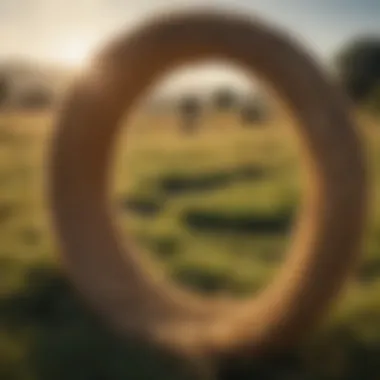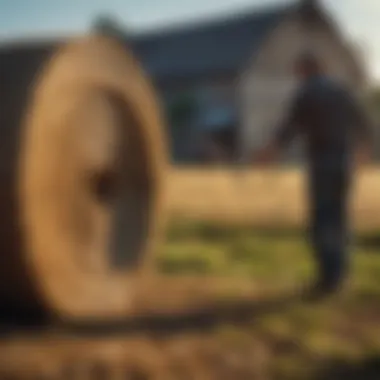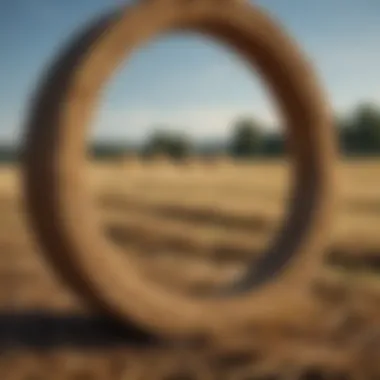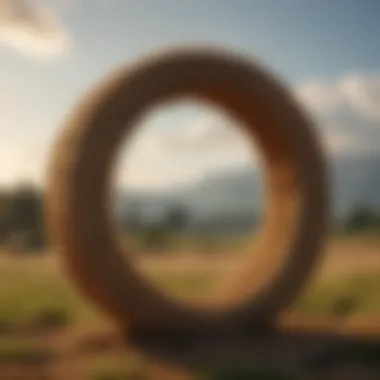Exploring Round Hay Rings for Sustainable Agriculture


Intro
In the context of sustainable agriculture, effective management of hay is crucial. Round hay rings serve as a practical solution for many farming operations. This article seeks to provide a comprehensive overview of round hay rings, including their significance, types, maintenance, and emerging trends. By understanding these elements, farmers can enhance their hay management strategies, ultimately contributing to sustainability within agricultural practices.
Overview of the Topic
Definition and Importance
Round hay rings are structures designed to hold and distribute hay for livestock consumption. These rings play a significant role in reducing waste and controlling feed access. When animals are not confined, they may tread on hay or scatter it, resulting in unnecessary loss. Utilizing round hay rings mitigates this waste and promotes efficient feeding practices.
Current Trends
The agricultural sector continues to evolve, with a rising focus on sustainability. Several trends are shaping the use of round hay rings:
- Material Innovation: New materials are being introduced to enhance durability and functionality.
- Design Upgrades: Improved designs are being created to cater to varied livestock sizes and types.
- Technology Integration: Some manufacturers are exploring smart technology for monitoring hay intake and ensuring proper nutrition.
Key Techniques and Practices
Step-by-Step Guide
Implementing round hay rings effectively involves a few key steps:
- Selecting the Right Ring: Assess your livestock's needs and the type of hay you offer.
- Placement: Position the rings in dry, flat areas to prevent mud and erosion.
- Monitoring: Regularly check the feed levels and adjust as needed to ensure animals have constant access.
Tools and Equipment Needed
To use round hay rings effectively, a few essential tools and equipment may be necessary:
- Hay Bales: Sufficient supply of hay to meet the livestock's dietary needs.
- Transport Equipment: Tractors or trailers for moving hay bales to the rings.
- Cleaning Tools: Shovels or rakes for maintaining cleanliness around the rings, discouraging pests and diseases.
Challenges and Solutions
Common Obstacles
While round hay rings are beneficial, there are challenges that farmers may face:
- Increased Initial Investment: Quality rings can represent a higher upfront cost.
- Maintenance Requirements: They require occasional upkeep to ensure longevity.
Innovative Solutions
To address these challenges, farmers can consider several solutions:
- Cost-Effective Options: Look for used or locally manufactured rings to save on costs.
- DIY Maintenance: Regular inspections and prompt repairs can extend the life of the rings while minimizing expenses.
Successful hay management depends not just on the equipment but also on the practices surrounding its use.
In summary, round hay rings represent a valuable investment for farmers interested in optimizing hay management practices. Understanding their definition, current trends, techniques, and challenges is essential for those looking to enhance sustainability in agriculture.
Foreword to Round Hay Rings
Round hay rings serve as a cornerstone in modern agricultural practices. They are designed to improve the efficiency of hay feeding in various farming contexts. Understanding their functionality and benefits is crucial for farmers who aim to enhance their livestock's nutrition while minimizing waste.
Definition and Purpose
A round hay ring is a structure used to contain and support hay bales fed to livestock. Its primary purpose is to reduce hay wastage during feeding times. By preventing livestock from trampling or scattering hay, these rings facilitate a more controlled feeding environment.


Farmers often appreciate that round hay rings can help ensure that animals have easier access to feed. As a result, this design enhances feed efficiency. Moreover, when managed properly, these rings contribute to better nutritional outcomes for livestock.
Historical Context
Historically, the feeding of hay to livestock involved less sophisticated methods, often leading to significant waste. Early methods did not provide the ideal conditions for maintaining the quality of hay. As the agricultural sector evolved, the introduction of round hay rings represented a significant shift. They not only reduced waste but also improved the overall management of feed resources. This evolution highlights the ongoing need for innovative solutions in agriculture.
The growth in awareness around sustainable practices has also increased interest in these feeding solutions. Farmers are now inclined to adopt methods that align with modern sustainability goals. Round hay rings are thus not just tools; they are part of a broader approach to responsible farming.
Types of Round Hay Rings Available
Understanding the available types of round hay rings is crucial for farmers and agricultural professionals who want to enhance their hay management practices. Each type offers distinct benefits and considerations that can impact the management of livestock feed. Choosing the right type effectively addresses the specific needs of farms, influencing efficiency and sustainability. Selecting the most suitable design and material is necessary for maximizing performance.
Material Composition
Metal
Metal round hay rings are widely recognized for their strength and durability. Steel, often galvanized to resist rust, is the common material in this category. The key characteristic of metal is its longevity, making it a popular choice for farms with rigorous demands. These rings usually withstand harsh weather conditions without significant wear. A unique feature of metal hay rings is their capacity to handle large bales while maintaining structural integrity. However, the weight of metal can be a disadvantage when it comes to mobility.
Plastic
Plastic round hay rings are designed for flexibility and ease of use. Made from high-density polyethylene, they are lightweight, which makes them easy to move around on the farm. The key characteristic of plastic is its resistance to corrosion, which means they can last long in varying environmental conditions without rusting. This material can be a beneficial choice, especially for farms that require frequent relocation of their hay management systems. However, these rings may not be as robust as metal, leading to concerns about their longevity under heavy use.
Wood
Wooden round hay rings offer an environmentally friendly option for hay management. Typically constructed from durable hardwood, they align with sustainable agricultural practices by using renewable materials. The key characteristic of wood is its natural aesthetic, appealing to those who prioritize farm appearance. However, while they perform well, wooden rings often require more maintenance than metal or plastic. They may succumb to rot or pests over time, potentially prompting a higher lifecycle cost if not properly cared for.
Design Variations
Portable Rings
Portable round hay rings are designed for easy relocation across the grazing field. Their lightweight construction provides farmers with the convenience of moving them according to livestock needs or pasture conditions. The key characteristic of portable rings is their mobility, making them a beneficial choice for rotational grazing practices. One unique feature is their versatility in various locations, though they may require additional maintenance due to frequent movement.
Stationary Rings
Stationary round hay rings, as the name implies, are meant to stay in one location. These rings generally weigh more, providing stability and minimizing risk of tipping. The key characteristic is sturdiness, making them an ideal option for feeding in a fixed area. A unique advantage is how they can efficiently keep feed organized, but their immobility can be a disadvantage for farms practicing rotational grazing.
Combined Feeders
Combined feeders incorporate hay rings with additional feeding solutions. These integrated models allow for simultaneous feeding of hay and grain, optimizing the feeding process. The key characteristic of combined feeders is their multifunctionality, which offers convenience to farmers. A significant advantage is the efficiency they provide; however, these models tend to be more complex and might require higher initial investment.
Key Insight: Choosing the appropriate type of round hay ring can greatly influence the sustainability of feed management practices on a farm. Understanding the material and design variations helps in making informed decisions.
By considering these elements, farmers can select the round hay ring that best aligns with their operational goals.
Benefits of Using Round Hay Rings
Round hay rings serve a crucial function in agricultural practice, particularly regarding feed management. Their advantages can translate into significant cost savings, improved animal health, and enhanced sustainability on farms. Understanding the benefits of these structures allows farmers to make informed decisions that align with both agricultural efficiency and environmental responsibility.
Enhanced Feed Efficiency
One primary benefit of using round hay rings is their ability to increase feed efficiency. When hay is provided without these rings, animals may scatter the feed, leading to spillage and wastage. Round hay rings contain the feed, allowing livestock to eat more effectively.
- Reduction of Feeding Time: Animals can access feed more readily, allowing them more time to graze rather than spend energy searching for food.
- Nutritional Intake: By directing animals toward the feed, farmers can ensure that livestock consumes the intended amount of nutrients. This leads to better growth rates and overall health.
- Cost Effectiveness: The decreased necessity for additional feed means that farmers can lower their operational costs over time.
"Investing in round hay rings can result in improved livestock productivity and lower feed costs, making it a wise investment for farmers."
Reduction of Waste


Waste reduction is another significant advantage of round hay rings. When hay is left unattended on the ground, it can be spoiled by exposure to moisture or trampled by livestock. This not only leads to financial loss but also adds to environmental degradation. Round hay rings help in minimizing such waste through various mechanisms:
- Controlled Feed Access: By limiting the animals' engagement with the hay, the feed remains contained and reduces spoilage.
- Alignment with Sustainable Practices: Fewer materials wasted contributes to better environmental outcomes, aligning agricultural practices with sustainability goals.
- Enhanced Pasture Management: Round hay rings facilitate better pasture management, enabling farmers to plan grazing rotations effectively.
Protection Against Contamination
The integration of round hay rings in hay management systems offers protection against environmental contaminants. Hay exposed directly to the elements can become contaminated, affecting its quality. When employing round hay rings, several factors come into play:
- Reduced Exposure to Elements: Hay stored in rings is often shielded from rain, snow, and muddy conditions, preserving its nutritional value.
- Minimization of Trash and Debris: By containing hay in a set location, there is less chance of the feed getting mixed with unwanted materials.
- Healthier Livestock: The reduction in feed contamination translates into better health for livestock, reducing veterinary costs and providing healthier produce.
In summary, the benefits of using round hay rings extend beyond simple feed management. Enhanced feed efficiency, waste reduction, and protection against contamination uniquely position these structures as essential elements in modern sustainable agriculture.
Factors to Consider When Purchasing Round Hay Rings
When making the decision to invest in round hay rings, it is essential to carefully evaluate the key factors that contribute to their effectiveness and longevity. These considerations not only affect the cost but also ensure that the investment aligns with the specific operational needs of a farm. A thoughtful approach can result in improved hay management and reduced waste, making it clear that these rings can serve as a fundamental asset in sustainable agriculture.
Size and Capacity Requirements
One of the primary factors to assess involves the size and capacity of the round hay ring. Farmers must first identify the herd size that will be utilizing the hay ring. A key consideration is that the ring should accommodate the amount of hay designated for feeding, while still providing sufficient space for all animals. A too-small ring can lead to competition over feed, potentially causing stress among livestock and inefficient grazing.
In addition to herd size, the type of livestock plays a critical role. For instance, larger animals such as cattle may require a more spacious design compared to smaller animals like sheep or goats. Furthermore, the dimensions of the round hay ring should complement the bales it will hold, whether they are small square bales or large round bales. Ensuring that the dimensions match will prevent difficulties during loading and feeding.
Durability and Maintenance
Next, durability is another significant factor when selecting a round hay ring. The material composition, whether it is metal, plastic, or wood, directly influences how long the ring will last under outdoor conditions. Metal rings, for example, are generally more resilient but may be prone to rust without proper treatment. On the other hand, plastic may not suffer from rust but could be vulnerable to breaking in extreme weather.
Regular maintenance practices are also essential. For instance, inspecting the ring for signs of wear and tear, cleaning it regularly to prevent contamination of feed, and ensuring all components are secure will prolong its usability. Farmers should establish a maintenance schedule considering the frequency of use and the environmental conditions.
Cost Analysis
Lastly, a thorough cost analysis is vital before acquiring a hay ring. While upfront costs may seem significant, it's crucial to consider long-term value. Investing in higher-quality rings may come with an initial price tag, but their durability and efficiency could translate to lower costs in terms of feed loss and maintenance over time. Conversely, opting for cheaper options may result in frequent replacements, ultimately increasing overall expenses.
In addition, farmers should calculate the potential savings generated from enhanced feed efficiency and reduced wastage. Comparing different ring options in terms of their cost, durability, and capacity allows for a better-informed decision. It is also advisable to examine warranties, as they provide insights into the manufacturer's confidence in their product.
Overall, the decision to invest in round hay rings involves careful consideration of size, durability, and cost. Evaluating these elements will help ensure that the investment supports sustainable agricultural practices while enhancing livestock nutrition.
Maintenance Practices for Round Hay Rings
Maintaining round hay rings efficiently can significantly enhance their lifespan and ensure optimal performance. Regular maintenance practices not only prevent early wear and tear but also assure the structural integrity of the rings. Proper care helps in maintaining the purpose of the rings, ultimately supporting sustainable agriculture practices. This section will delve into two critical aspects of maintenance: regular inspections and cleaning protocols.
Regular Inspections
Conducting regular inspections is crucial for the longevity of round hay rings. Farmers should schedule these checks at various intervals, ideally at least once a month. Inspections should focus on several key areas:
- Structural Integrity: Look for any signs of bending, cracking, or any other forms of damage. These issues can affect the overall functionality.
- Worn Components: If the rings have moving parts, assess them for wear. Loose or damaged components may lead to safety issues and may render the rings unserviceable.
- Rust and Corrosion: Metal rings are particularly susceptible to rust. Consistent examinations can help identify these problems early, allowing for prompt remediation.
- Attachment Points: Check areas where components join, as these spots are more prone to wear. Ensure they are securely fastened to avoid mishaps.
Taking time for these inspections not only saves time and money in the long run but also helps maintain the health of livestock by ensuring that the feeding structures are safe.
Cleaning Protocols
Maintaining cleanliness is another vital aspect that should not be overlooked. Round hay rings can accumulate debris, soil, mold, or even leftover feed over time. Implementing effective cleaning protocols greatly impacts their functionality and hygiene:
- Frequency of Cleaning: Ideally, hay rings should be cleaned after every hay use or at least weekly, depending on the number of animals. This prevents spoilage and contamination of the feed.
- Cleaning Tools and Supplies: Use simple tools like brooms, shovels, and water. For tougher grime, a mixture of water and vinegar can be effective without introducing harmful chemicals.
- Thorough Removal of Debris: Clear out any leftover feed and other materials. Not only does this help in maintaining hygiene, but it also prevents attracting pests and rodents.
- Inspect During Cleaning: Use the cleaning times to perform inspections, checking for any damage as previously mentioned. This creates an efficient cycle of maintenance.
Proper maintenance of round hay rings is essential to ensure that they serve their purpose effectively while supporting overall farm sustainability.


By consistently applying these maintenance practices, round hay rings remain functional and contribute positively to livestock nutrition and farm productivity.
Round Hay Rings and Sustainable Practices
Round hay rings play a significant role in promoting sustainable practices in agriculture. Their purpose extends beyond merely serving as feeding equipment; they contribute to a more efficient, resourceful, and environmentally friendly farming approach. Adopting these hay rings can create a positive ripple effect on the agricultural ecosystem.
Using round hay rings can greatly assist in better hay resource management. When livestock feed consumes hay directly from the ground, more wastage occurs. This not only translates to a loss of valuable resources but also creates environmental issues such as soil degradation. With proper use of round hay rings, farmers can significantly reduce this waste. Over time, they help to maximize feed efficiency while minimizing unnecessary environmental impact.
Contribution to Soil Health
The relationship between round hay rings and soil health is particularly noteworthy. When livestock feed on hay that is spread across the ground, trampling occurs, which can lead to soil compaction. Compacted soil can impede water absorption and root development, negatively impacting plant growth.
By using round hay rings, farmers can effectively limit livestock access to the soil. This alleviates the risk of soil compaction and encourages healthier, more robust soil ecology. Healthier soil promotes diverse microbial activity, enhances nutrient cycling, and ultimately supports crop production. As such, the implementation of round hay rings not only aids in livestock feeding but also enriches the soil naturally.
Impact on Livestock Health
The advantages of round hay rings are not limited to agricultural practices alone but extend to livestock health as well. When hay is stored in a ring rather than scattered, it offers a distinct benefit. Livestock have easier access to food, which ensures they consume the necessary nutrients. This plays an essential role in maintaining their overall health.
Proper feeding practices result in improved digestion and nutrient absorption for the animals. Furthermore, round hay rings can mitigate the risk of potential health hazards. When hay sits on the ground, it can become contaminated by dirt or feces, posing a risk of diseases to livestock. By using a hay ring, farmers ensure cleaner feeding areas and healthier livestock.
"Investing in round hay rings is not just an investment in equipment; it is an investment in the future sustainability of farming."
Emerging Trends in Hay Management Equipment
As the agricultural landscape evolves, emerging trends in hay management equipment gain significance. These trends highlight the need for innovation and adaptability in farming practices. For many farmers, understanding these shifts can lead to improved efficiency, productivity, and sustainability in their operations. Utilization of modern technology plays a crucial role in achieving these goals.
Technological Innovations
The introduction of sophisticated machinery is essential in hay management. Various technological innovations are transforming how farmers produce, store, and distribute hay. Examples include:
- Automated Hay Balers: These machines improve the speed and precision of hay production, ensuring consistent bale sizes that enhance storage and feeding.
- GPS Technology: This technology aids in planning and executing efficient cutting and harvesting routes, saving time and fuel.
- Data Analytics Tools: These help farmers analyze their hay crops efficiently. Farmers can monitor crop health and yield using sensors and satellite imaging.
These innovations increase productivity while reducing labor and costs over the long term. Investing in such technologies aligns with sustainable goals by optimizing resource usage.
Integration with Smart Farming Solutions
The concept of smart farming is revolutionizing agricultural practices. This approach integrates various technologies to create a more efficient workflow. When it comes to round hay rings and hay management, smart farming solutions offer several advantages:
- Real-Time Monitoring: Farmers can track the health of their livestock and the condition of their hay in real time. This can prevent waste and improve animal nutrition.
- Resource Allocation: Smart systems help determine when and how much hay to distribute. This ensures that livestock always have the right amount of feed, reducing overfeeding and waste.
- Environmental Sustainability: With precise data on hay usage, farmers can adjust practices that would benefit soil and crop health.
Incorporating these solutions requires an understanding of emerging communication technologies as well. This establishes connectivity between different farming equipment for seamless operation. Overall, embracing smart solutions will undoubtedly prepare farmers for future challenges in hay management.
The drive toward technological advancements and smart farming solutions is not merely a trend—it's a transition toward a more sustainable future in agriculture.
Closure
In the context of sustainable agriculture, the conclusion serves as a crucial element that encapsulates the significant insights derived from the earlier sections of the article. This part reinforces the overarching theme of the importance of round hay rings in modern farming practices. As we have explored, these equipment pieces play a pivotal role in enhancing feed efficiency, reducing waste, and ensuring livestock health through proper hay management. Additionally, they support sustainable practices that contribute positively to soil health and overall farm productivity.
The adoption of round hay rings should not be viewed merely as a cost but rather as an essential investment that aligns with long-term agricultural sustainability goals. By carefully evaluating types, materials, and maintenance options, farmers can optimize their operations and promote environmental stewardship. Consequently, the decision to incorporate round hay rings reflects a commitment to enhancing productivity while mitigating negative impacts associated with traditional hay management methods.
"Investing in round hay rings is not just about immediate benefits; it’s about fostering a sustainable future for agriculture."
Summary of Key Points
The key points discussed throughout this article highlight the various advantages and considerations surrounding round hay rings. These include:
- Enhancement of Feed Efficiency: Effective feeding strategies lead to improved livestock performance.
- Waste Reduction: Round hay rings significantly minimize hay wastage through controlled feeding.
- Protection Against Contamination: They keep hay clean and dry, protecting it from elements and contaminants.
- Maintenance Practices: Regular cleaning and inspections extend the life and utility of the rings.
- Emerging Trends: Technological advancements and smart farming integrations represent the future of hay management.
Future Outlook for Round Hay Rings
Looking forward, the future of round hay rings will likely be influenced by several emerging trends in the agricultural sector. As the industry adapts to new challenges such as climate change and economic pressures, innovations in design and functionality are expected to arise. Businesses may focus on developing more durable materials for longevity and enhanced features for efficiency
Sustainability will continue to be a driving force, leading to the integration of smart technologies. Implementation of sensors and IoT capabilities could provide real-time data regarding hay consumption and health management of livestock.



